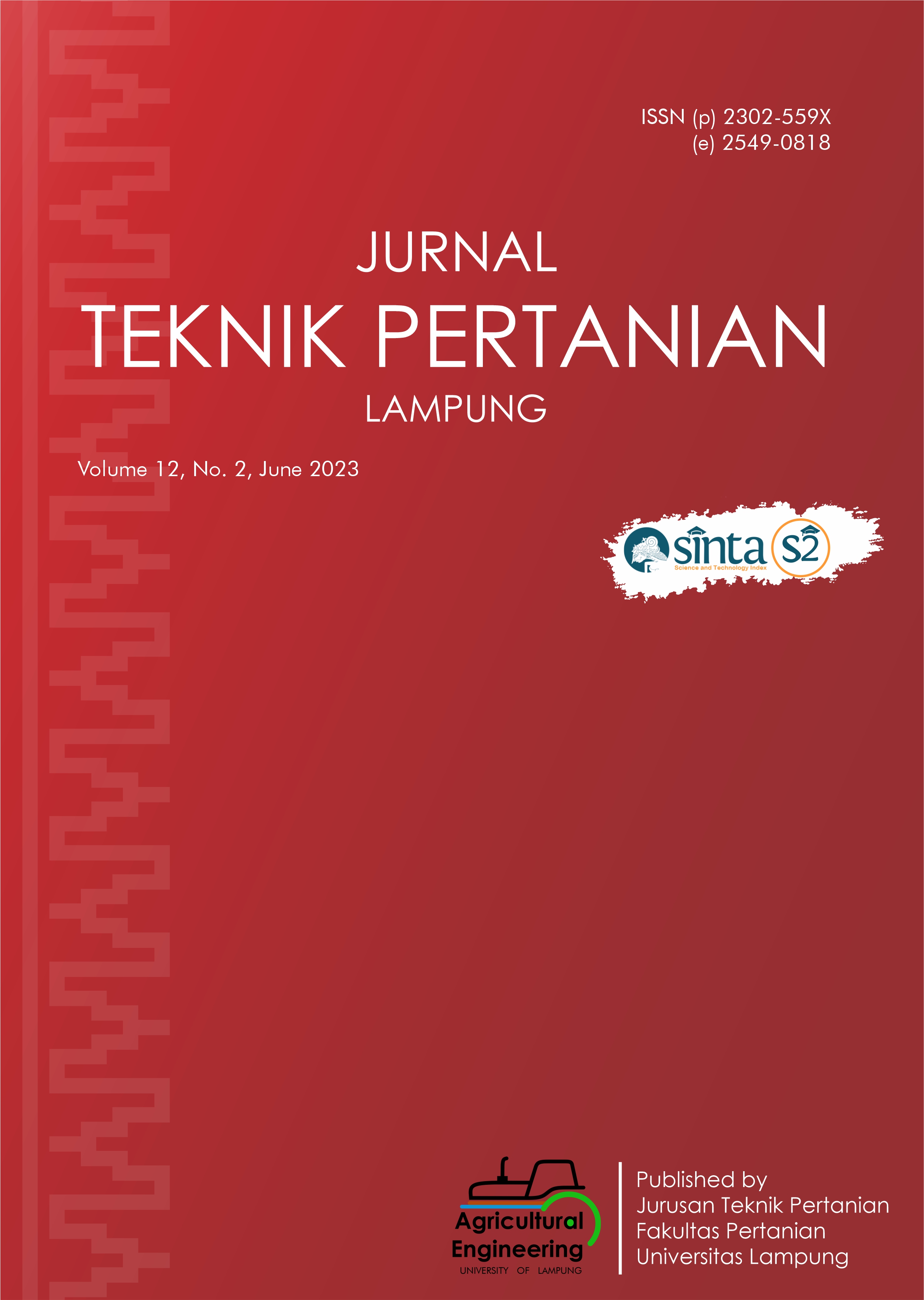Design and Implementation of IOT-Based Monitoring System on Nanobubble-Based Hydroponics Farming
DOI:
https://doi.org/10.23960/jtep-l.v12i2.470-483Abstract
Maintaining Dissolved Oxygen (DO) levels in the hydroponic plant nutrient solutions can be done using nanobubble technology. Manual monitoring can be time-consuming and measurement results are less accurate. Therefore, a monitoring system is needed to monitor air temperature, air humidity, water temperature, water pH, nutrient concentrations, and DO levels. Several stages in this research are preparation, design, sensor calibration, and monitoring system implementation. Air temperature and humidity conditions can be measured with the DHT22 sensor, water temperature can be measured with the DS18B20 sensor, water pH can be measured with the Analog pH Meter Pro, nutrient density can be measured with the Analog TDS sensor, and DO levels can be measured with the Dissolved Oxygen Sensor. Based on the measurement results monitored by the monitoring system, the parameters that affect the ignition of the nanobubble generator are DO values and water temperature. The system can also visualize sensor data on monitors and online, and can store sensor data locally and IoT so that this system has the potential to monitor hydroponics, especially nanobubble-based hydroponics.
Keywords: Sensor, Dissolved Oxygen, Arduino Uno, ESP32-E, NodeMCU ESP8266
References
Alam, H.S., Sutikno, P., Fauzi Soelaiman, T.A., & Sugiarto, A.T. (2022). CFD-PBM Coupled modeling of bubble size distribution in a swirling-flow nanobubble generator. Engineering Applications of Computational Fluid Mechanics, 16(1), 677–693. https://doi.org/10.1080/19942060.2022.2043186
Alam, H.S., Sutikno, P., Soelaiman, T.A.F., & Sugiarto, A.T. (2021). Bulk nanobubbles: Generation using a two-chamber swirling flow nozzle and long-term stability in water. Journal of Flow Chemistry, 12, 161–173. https://doi.org/10.1007/s41981-021-00208-8
Anika, N., & Putra, E.P.D. (2020). Analisis pendapatan usahatani sayuran hidroponik dengan sistem deep flow technique (DFT). Jurnal Teknik Pertanian Lampung, 9(4), 367. https://doi.org/10.23960/jtep-l.v9i4.367-373
Assa, F.B., Rumagit, A.M., & Najoan, M.E.L. (2022). Internet of things-based hydroponic system monitoring design perancangan monitoring sistem hidroponik berbasis Internet of Things. Jurnal Teknik Informatika, 17(1), 129–138.
Burange, A.W., & Misalkar, H.D. (2015). Review of Internet of Things in development of smart cities with data management & privacy. Conference Proceeding - 2015 International Conference on Advances in Computer Engineering and Applications, ICACEA 2015, 189–195. https://doi.org/10.1109/ICACEA.2015.7164693
Doni, R., & Rahman, M. (2020). Sistem monitoring tanaman hidroponik berbasis iot (internet of thing) menggunakan Nodemcu ESP8266. Jurnal Sains Komputer & Informatika (J-SAKTI), 4(2), 516–522.
Farooq, M.S., Riaz, S., Abid, A., Abid, K., & Naeem, M.A. (2019). A survey on the role of IoT in agriculture for the implementation of smart farming. IEEE Access, 7, 156237–156271. https://doi.org/10.1109/ACCESS.2019.2949703
Ismail, & Syam, A. (2019). Edukasi teknologi hidroponik untuk pemberdayaan lahan pekarangan. Jurnal Dedikasi, 21(2), 105–109. https://doi.org/10.26858/dedikasi.v21i2.11477
Kilmanun, J.C., & Ndaru, R.K. (2020). Analisis pendapatan usahatani sayuran hidroponik di Malang, Jawa Timur. Jurnal Pertanian Agros, 22(2), 180–185.
Liu, S., Oshita, S., Kawabata, S., Makino, Y., & Yoshimoto, T. (2016). Identification of ROS produced by nanobubbles and their positive and negative effects on vegetable seed germination. Langmuir, 32(43), 11295–11302. https://doi.org/10.1021/acs.langmuir.6b01621
Ljunggren, S., & Eriksson, J.C. (1997). The lifetime of a colloid-sized gas bubble in water and the cause of the hydrophobic attraction. Colloids and Surfaces A: Physicochemical and Engineering Aspects, 129–130, 151–155. https://doi.org/10.1016/S0927-7757(97)00033-2
Matsuki, N., Shingo, Takuji, I., Osamu, I., Motohiro Takeda, N., Ujike, Y., & Yamaguchi, T. (2012). Blood oxygenation using microbubble suspensions. Eur Biophys J, 41, 571–578. https://doi.org/10.1007/s00249-012-0811-y
Mulyono, S., Qomaruddin, M., & Syaiful Anwar, M. (2018). Penggunaan node-RED pada sistem monitoring dan kontrol green house berbasis protokol MQTT. Jurnal Transistor Elektro Dan Informatika (TRANSISTOR EI), 3(1), 31–44.
Nasarudin, M., Putra, G.M.D. Haji Abdullah, S., & Setiawati, D.A. (2020). Sistem kendali penggunaan air irigasi dengan aplikasi smartphone berbasis kelembaban tanah. Jurnal Teknik Pertanian Lampung, 9(3), 248. https://doi.org/10.23960/jtep-l.v9i3.248-256
Pamungkas, L., Rahardjo, P., & Agung, I.G.A.P.R. (2021). Rancang bangun sistem monitoring pada hidroponik NFT (Nutrient Film Tehcnique) berbasis IoT. Jurnal Spektrum, 8(2), 9–17.
Salim, T. I., Haiyunnisa, T., & Alam, H. S. (2016). Design and implementation of water quality monitoring for eel fish aquaculture. 2016 International Symposium on Electronics and Smart Devices (ISESD), 208–213. https://doi.org/10.1109/ISESD.2016.7886720
Saputri, A., MTS, J., & Rahayu, D. (2014). Analisis sebaran oksigen terlarut pada Sungai Raya. Jurnal Teknologi Lingkungan Lahan Basah, 2(1). https://doi.org/10.26418/JTLLB.V2I1.4618
Sulistyowati, L., & Nurhasanah, N. (2021). Analisa dosis AB mix terhadap nilai TDS dan pertumbuhan pakcoy secara hidroponik. Jambura Agribusiness Journal, 3(1), 28–36. https://doi.org/10.37046/jaj.v3i1.11172
Susanto, B.M., Atmadji, E.S.J., & Brenkman, W.L. (2018). Implementasi MQTT protocol pada smart home security berbasis web. Jurnal Informatika Polinema, 4(3), 201. https://doi.org/10.33795/jip.v4i3.207
Susilawati. (2019). Dasar-Dasar Bertanam secara Hidroponik. Palembang: Unsri Press.
Yuliantari, R., Yuliantari, R.V., Novianto, D., Hartono, M.A., & Widodo, T.R. (2021). Pengukuran kejenuhan oksigen terlarut pada air menggunakan dissolved oxygen sensor. Jurnal Fisika Flux: Jurnal Ilmiah Fisika FMIPA Universitas Lambung Mangkurat, 18(2), 101–104. https://doi.org/10.20527/flux.v18i2.9997
Downloads
Published
Issue
Section
License
- Authors who publish with this journal agree to the following terms:
- Authors retain copyright and grant the journal right of first publication with the work simultaneously licensed under a Creative Commons Attribution-ShareAlike 4.0 International Lice that allows others to share the work with an acknowledgement of the work's authorship and initial publication in this journal.
- Authors are able to enter into separate, additional contractual arrangements for the non-exclusive distribution of the journal's published version of the work (e.g., post it to an institutional repository or publish it in a book), with an acknowledgement of its initial publication in this journal.
- Authors are permitted and encouraged to post their work online (e.g., in institutional repositories or on their website) prior to and during the submission process, as it can lead to productive exchanges, as well as earlier and greater citation of published work (See The Effect of Open Access).
Jurnal Teknik Pertanian Lampung

JTEPL is licensed under a Creative Commons Attribution-ShareAlike 4.0 International License.

